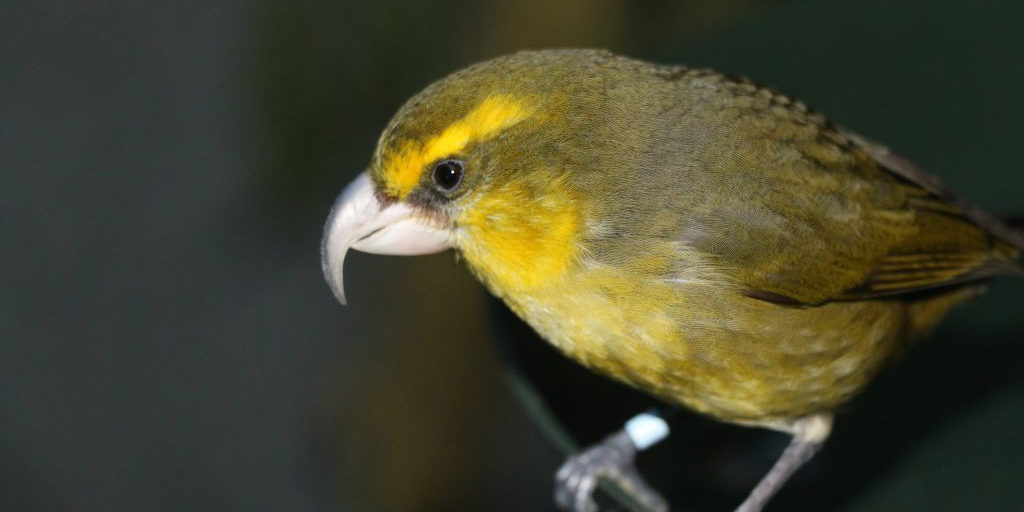Bird of The Week: Kiwikiu
SCIENTIFIC NAME: Pseudonestor xanthophrys
POPULATION: Less than 300
IUCN STATUS: Critically Endangered
TREND: Decreasing
HABITAT: Wet montane forests
The Kiwikiu, or Maui Parrotbill, is so rare that it had no Hawaiian name, or that name was lost over time. This olive-green and yellow, large-billed native honeycreeper was considered extinct during the first half of the 1900s, until it was rediscovered in 1950. In 2010, to celebrate its heritage and survival, a mele inoa, or naming chant, gave the Maui Parrotbill the name Kiwikiu in the ‘Ōlelo Hawai‘i (Hawaiian language).
Once widespread on the islands of Maui and Moloka‘i, the Kiwikiu has disappeared from most of its former range, much as the Palila has disappeared from Hawai‘i Island and the ‘I‘iwi from across the state.
Threats from Tiny Terrors
The Kiwikiu and most other Hawaiian honeycreepers have no immunity to introduced avian malaria and avian pox, diseases transmitted by non-native mosquitoes. These diseases are nearly always fatal to honeycreepers, and a single bite by a malaria-infected mosquito is deadly to some species.
Mosquitoes arrived in 1826; pox soon thereafter, and malaria was established by the early 1900s. The combination of all three devastated Hawai‘I’s native birds.
In response to the mosquitos arrival, some of Hawai‘I’s bird species went extinct. Most retreated to habitats at elevations above the mosquito zone, and the Kiwikiu is just managing to survive. Climate change is exacerbating the mosquito threat, as warming temperatures allow mosquitoes and disease to move higher into the remaining forest birds’ mountain strongholds.
The Kiwikiu’s tiny population is now confined to an area totaling fewer than 11 square miles of remote, high-elevation rainforest on the north and east slopes, or windward side, of east Maui.
A Vanishing Song
The Kiwikiu’s song, heard as the birds forage slowly through native forest understory, is a series of paired notes that sound like chewy-chewy-chewy.
Multi-purpose Mandibles
The Kiwikiu’s heavy, parrotlike bill comprises a long, decurved upper mandible and shorter lower mandible with a chisel-like tip. Like the bill of the ʻAkiapōlāʻau, another native honeycreeper, the Kiwikiu’s bill serves as a multi-purpose tool that allows the bird to split and chisel open dead wood and branches, pry up bark and lichens, and slice open fruit in search of the insects and larvae that make up most of its diet. The Kiwikiu also probes native flowers for nectar.
This species is one of the most sexually dimorphic of Hawaiian honeycreepers. Male Kiwikiu are noticeably larger than females, with brighter yellow plumage. It’s a long-lived species — birds have been recorded as old as 16 years — and forms pair-bonds that last for life.
Kiwikiu reproduce slowly, only hatching a single chick every year or two. The young, which the parents feed through regurgitation, also mature slowly and remain with their parents from five months to nearly a year and a half.
Keeping the Kiwikiu Singing
Like the ‘Akikiki, the Puaiohi, and other native forest birds, the Kiwikiu is primarily threatened by non-native species, habitat loss and alteration, and climate change. Wide-scale deforestation for agriculture and livestock grazing have reduced forest cover on the island of Maui to a fraction of former levels, while invasive plant and animal species have further eroded the native forest and reduced its quality throughout the island.
Saving the Kiwikiu is one of the top priorities of ABC’s Hawai‘i Program. In 2019, working with partners including the Hawai‘i Department of Forestry and Wildlife, Maui Forest Bird Recovery Project, San Diego Zoo Global, and National Fish and Wildlife Foundation, we translocated Kiwikiu to newly restored forest on the southwestern slope of Haleakalā. Unfortunately, and in spite of careful planning, the attempt to establish a new population of the endangered species failed: The translocated birds died from avian malaria associated with an unexpected mosquito irruption at the release site.
Undeterred, ABC is taking a leadership role in developing and implementing a biotechnical solution to suppress mosquito populations in Hawai‘i, halting the spread of avian diseases and future bird extinctions. Look for more updates soon.
SOURCE: American Bird Conservancy (abcbirds.org)


